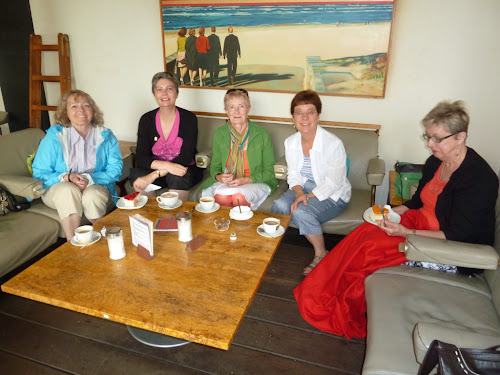We started the day on Sunday by driving out to the city of Halle, where we attended a German church service at the Marktkirche (thankfully only an hour long!) Halle is the birthplace of George Fredric Handel and he was baptized at this church.
It was interesting to hear our guide say that Halle was one of the least damaged cities during the war. But following the war, a whole new area of the city was constructed known as Halle Neustadt (new town) in which ugly communist-era housing was constructed. Thankfully the beautiful architecture of the older part of the city remains.
After the morning church service, several people decided to visit the Handel Museum. I decided instead to spend some time relaxing in one of the sidewalk cafes and taking in the ambiance.
Chocolate orange kuchen and milchcaffe
The others joined me later for a quick coffee inside the restaurant (L-R: Gail, Caryn, Gailene, Marilyn, Maureen)
Next we visited the Franckesche Stiftungen (Foundations), founded by August Francke as a school for deprived and orphan children in 1695 and advancing into a place of pedagogical innovations and a world-famous educational institution.
A view of the city of Halle from the fifth floor observatory of the Franckesche Stiftungen
The Francke Foundation library, which contains numerous books printed during the period following the invention of the Guttenberg Press
On the road to Eisleben, a very picturesque drive through a fruit growing area
Lake and small castle on the road to Eisleben
The interior of the church was extensively renovated in 2011, so looks very different (much more modern) from most of the churches we've seen so far.
The pews and pulpit were made of the most exquisite fruitwood.
Andreaskirche (St Andrews Church), where Luther preached his last sermon
The church pulpit













No comments:
Post a Comment